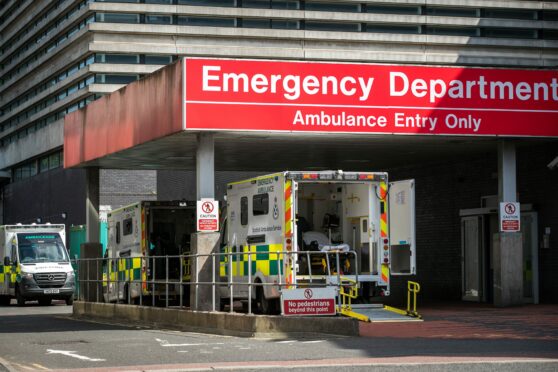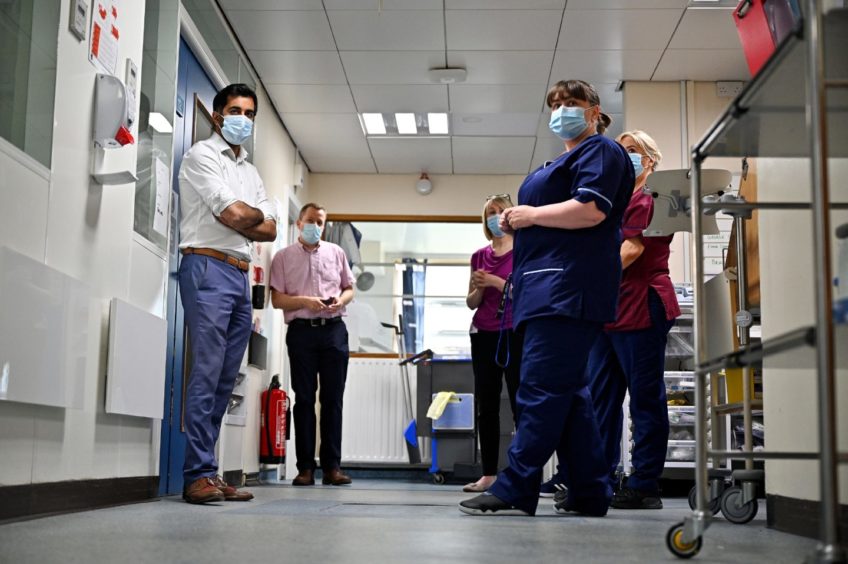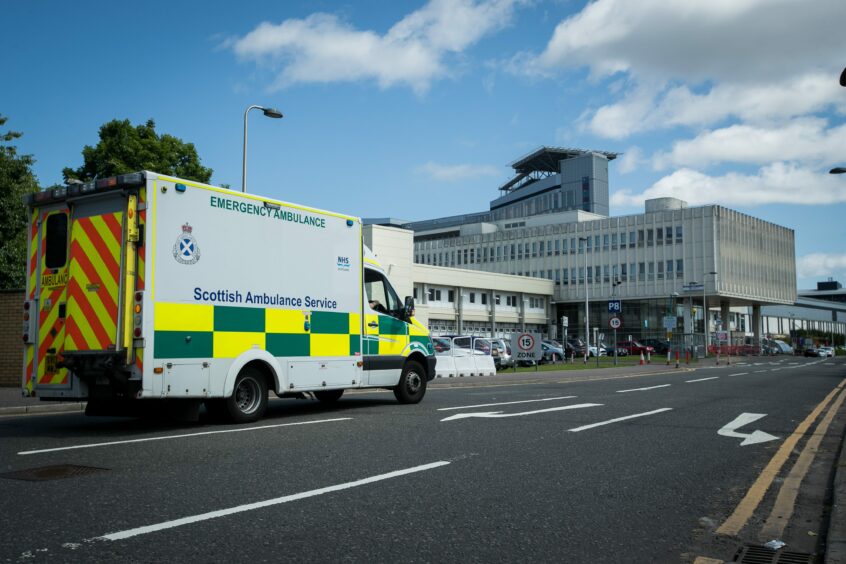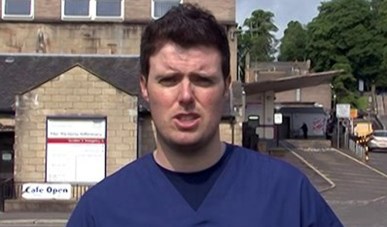
Accident and emergency wards in Scotland’s hospitals are overwhelmed and buckling under the pressure of too many patients and too few staff, doctors warn today.
Medical staff say ambulances are often forced to queue outside because there is nowhere to put patients, while some people are waiting as long as 12 hours to see a doctor.
Weekly figures for the first week in July show one in five patients waited more than four hours, with 113 spending 12 hours or more in an emergency department.
However, one A&E doctor in Glasgow said some daily figures were alarming and exposed the untenable pressure as more and more patients arrive at understaffed departments.
The doctor said: “The target is to see 95% of patients within four hours, but on the busiest days that is down in the 70s, the 60s, sometimes the 50s. At one hospital, I was told it has been in the 40s.
“People can be waiting eight to 12 hours for a bed in A&E. Outside there will be a line of ambulances queued up with patients inside because there is nowhere to put them.
“There are huge gaps in A&E. From one day to the next, we do not have enough doctors. It’s self-quarantining…people are getting pinged on the app and going into self-isolation. Now doctors and nurses are deleting the app. I’ve deleted mine. The feeling is we’ve been double-jagged, we need to go to work.
“But it’s not just that. People are scunnered, exhausted. Nurses that used to do extra shifts in their hospital are going to agencies and doing better-paid shifts in other health boards.
“Across the hospital, we’re scores of nursing shifts down a day. There are wards being staffed by two nurses when there should be eight.”
‘Whack-a-mole’ shifts
The doctor said the difficulties in primary care where fewer patients are being seen in person by GPs mean more are attending casualty where he compared his shifts to playing “whack-a-mole”, adding: “I’m constantly spinning plates. It’s like pushing water up a hill.
“It’s trying to make people safe but we can’t give them the care they need. It’s grim, really grim. It’s hard to think it could get worse, but that’s the fear because this is us in the middle of summer. Winter will be far worse. And there does not seem to be a plan. We don’t know how it can be fixed.”
The Scottish Government A&E target is for 95% of patients to be seen by a doctor within four hours but the most recent monthly figures for May show that target was missed, with one in nine waiting longer, sometimes more than 12 hours.
Rising Covid cases are expected to increase pressure on hospitals while the Office for National Statistics said that one in every 90 people in Scotland was infected with Covid last week, up from one in every 100 the previous week.
Current hospital admissions are already above forecasters’ worst-case scenario, which predicted cases would plateau below 500 cases by mid-July. There are still more than 500 people in hospitals with Covid.
A survey published by the Royal College of Emergency Medicine (RCEM) last week echoed concern the staffing crisis across Scotland was putting patients at risk. The college said Scotland’s emergency departments needed 113 more consultants and 180 more junior doctors over the next five years. RCEM has also called for 1,000 more hospital beds.
Dr John Thomson, vice-president of the RCEM Scotland, said: “Ambulances have to wait outside the emergency department until clinical space is available, sometimes for hours. That has an implication for the individual patient who is not getting the care they potentially require at the time they require it.
“However, it actually has a much bigger impact on the community because ambulances can’t respond to other people in the community who may have emergency needs because they’re parked outside emergency departments.
“There is now a clear and growing increased risk of harm both to the patients waiting to get into emergency departments but also those patients in the community that may require an urgent response.”
Thomson said in previous years the summer months offered some respite to overworked emergency department staff, but not this year.
He said: “Hospital capacity tends to be better in summer months and worse in winter months. What we’re seeing at the moment in summer is winter levels of presentations of patients. A number of departments are having significant increases in the number of presentations, at least 25% month on month in the last few months.
“May was our worst month ever in terms of national performance, with more 12-hour breaches than we’ve ever had previously. Likewise in terms of four-hour breaches. That is the indicator of the pressures on the system.
“There is no suggestion June is going to be any better when that data is released. There is concern this winter is going to be our most challenging ever because we’re already in a situation where our hospitals have no capacity and that’s reflected in our poor performance board by board. We are seeing a continuing deterioration in the national performance.
“Patients are spending far longer in emergency departments than we would like them to, with the known effects on morbidity and mortality associated with that.
Adding to that is the number of staff who are unable to work due to being Covid contacts. The nurse-to-patient ratios in wards are not ideal – one nurse to 10 patients rather than one nurse to six patients in some wards.
“There is inadequate capacity in hospitals to deal with the unscheduled care workload. We knew that before Covid and we’ve been calling for an increase in the number of beds. We are about 1,000 beds short. That’s why patients are waiting so long.
“There also needs to be an understanding of the need for an increased workforce to deal with increased demands.”
Calvin Lightbody, A&E consultant at Hairmyres Hospital, Lanarkshire, said: “Over the last few weeks, our A&E departments have been as busy as any time I can remember in recent years. We had nearly 700 patients in a single day last week across the three hospitals.”
Extra funding
Health Secretary Humza Yousaf has attempted to ease pressure on hospitals by releasing an additional £12 million to help reduce waiting times for non-Covid emergency care. He said: “As restrictions begin to relax, we have seen a rise in admissions and non-Covid attendances, with levels returning to pre-Covid averages over recent weeks.
“To minimise pressures, I announced £12m in additional funding to health boards across Scotland to support non-Covid emergency care. This immediate action will help put measures in place to reduce waiting times for urgent or emergency treatment, with a focus on boosting staffing levels and available beds.
“It is vitally important that there are no unnecessary delays for ambulances when taking patients to hospital and we continue to work closely with the ambulance service and with health boards across the country to ensure our ambulances are cleared as quickly as possible.”
However, Dr John-Paul Loughrey, RCEM Scotland vice-chair, who works in A&E at a Glasgow hospital, said the funds would not solve the immediate issues.
He said: “There has been increased funding provided to emergency care recently but the difficulty is there really aren’t the doctors and nurses out there that are available and are trained and skilled in emergency medicine to fill the gaps.”
The Scottish Ambulance Service said: “The Scottish Ambulance Service and local health boards communicate daily and have joint escalation plans in place that manage the risks of increased ambulance delays at hospital. A number of other steps are also being taken to minimise ambulance waiting times including discharge planning to maintain patient flow and increasing alternative care pathways for ambulance clinicians to support patients in the community.”
NHS Greater Glasgow and Clyde said: “Despite a recent increase in the number of people presenting to emergency departments, our staff continue to see and treat the vast majority of patients within four hours. However, we apologise to those patients who have to wait long periods of time for treatment.
“Occasionally, like other hospitals across Scotland, there are instances of ambulances queuing outside of the hospital. When this does occur, it is escalated to senior staff immediately and measures are taken on site to address the situation to enable timely management of patients’ care.
“Pressure points can develop in specific areas at different times. If necessary, we are usually able to divert ambulances to our other hospitals to ensure patients receive emergency treatment as soon as possible.
“While there are staffing challenges, we review these on a shift-by-shift basis to ensure staffing requirements are maintained to a level which is considered safe for patients. This might include moving staff from other areas, or using our pool of bank nurses to fill shifts. An active recruitment campaign is also under way.
“In line with national guidance, staff working in a healthcare requirement are not required to have the Protect Scotland app on.”
I have to steel myself before a shift. Every day is pressured and we are all so tired
Dr John-Paul Loughrey, vice chair of the Royal College of Emergency Medicine Scotland, works in A&E at a Glasgow hospital
The difficulties we’re seeing across the country are more acute in the west. There are times when outside some of the major hospitals in Glasgow we have four, five, six ambulances waiting to offload patients into already overwhelmed departments. In the mornings we’re coming in to 40 or 50 patients already in the department, many of whom are waiting for beds. On occasion, we’re diverting some patients from one hospital emergency department to another in order to manage the workload.
That can be very challenging for patients, to end up in a hospital that’s not local to them or their families.
It’s also challenging to teams that are sometimes unfamiliar with their previous care. It causes a lot of friction between clinicians in emergency departments when it feels like you’re taking on other people’s work. It’s putting a lot of pressure and stress not just on emergency departments but on medical receiving units and primary care.
Just now we have a number of unfilled consultant posts across Glasgow through some sickness and some maternity posts that have been unfilled. That means there are consistent gaps that are having to be filled by staff that work in those departments and occasionally those shifts just go unfilled. That’s not just a problem in my hospital, it’s consistent across the piece.
We’re all so tired. Every day is pressured. It feels like it’s winter in summer. I have to steel myself before my shift for what I’m about to face. It’s not knowing what’s going to happen if, when you show up, another two doctors have called in sick or have been told to self-isolate. It’s very difficult to try to prepare yourself for that.
There are times when we feel like we could be doing better for patients. I have particular anxieties about the patients who spend a long time in emergency departments waiting for beds to become available. Those generally aren’t young, fit patients who are capable of looking after themselves for periods of time. They are often frail and elderly patients.
That’s not a problem unique to my hospital or indeed to Glasgow. Hospitals around the west of Scotland are experiencing similar, where 10 to 12 hours in an emergency department feels like standard at times. Over the last eight weeks we’ve had more than 100 patients in Scotland waiting more than 12 hours to be admitted to hospital, which is unprecedented.
There is good evidence that patients who spend longer in emergency departments do worse than patients who have a shorter length of stay. That’s not just for patients who are eventually admitted to hospital, that’s for those who are discharged, too.
If more patients are spending more time in emergency departments then those patients wouldn’t do as well as if they had gone directly to a ward after they had been deemed fit for admission and requiring that.
Long emergency department stays and crowding do have mortality implications, in that people have a greater risk of mortality, certainly for those who are frail and vulnerable.

Enjoy the convenience of having The Sunday Post delivered as a digital ePaper straight to your smartphone, tablet or computer.
Subscribe for only £5.49 a month and enjoy all the benefits of the printed paper as a digital replica.
Subscribe © PA
© PA © Supplied
© Supplied © Andrew Cawley
© Andrew Cawley